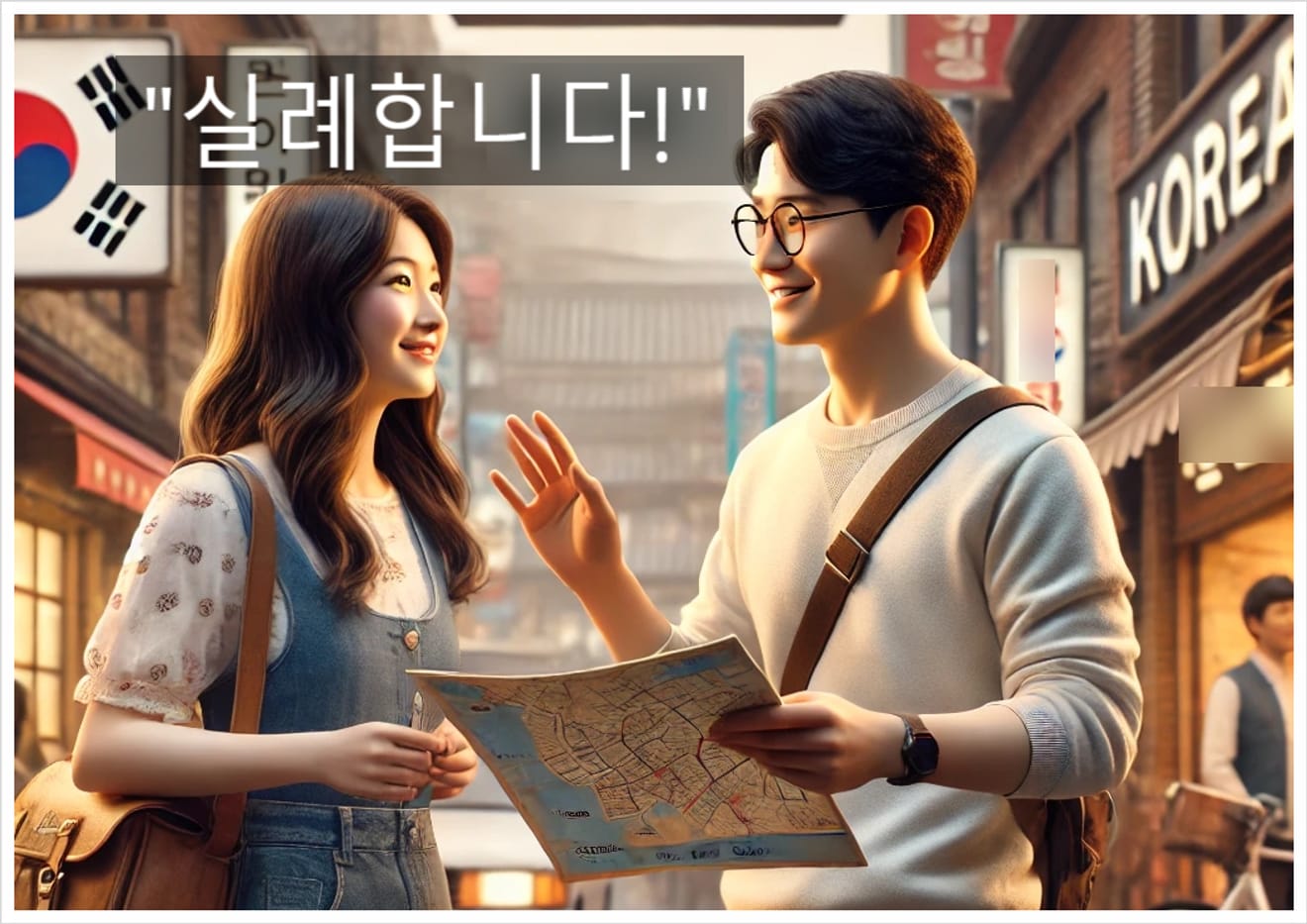Subject
- #Expression
- #Apology
- #Understanding
- #Korean Language
- #Silleyhamnida (실례합니다)
Created: 2024-10-22
Updated: 2024-11-24
Created: 2024-10-22 21:54
Updated: 2024-11-24 16:37
Hello! Today, we will learn the expression "Sil-lye-hamnida!" (실례합니다!), a common and polite way to get someone's attention or ask for directions in Korea. This phrase can be translated as "Excuse me" or "Pardon me," and it's essential for foreigners to communicate effectively in Korea. In this article, we will cover the correct pronunciation of "Sil-lye-hamnida!" (실례합니다!), its usage, various examples in different situations, and tips related to etiquette in Korean culture."Sil-lye-hamnida!" (실례합니다!)This expression is crucial for smooth communication for foreigners in Korea."Sil-lye-hamnida!" (실례합니다!)We'll also discuss its accurate pronunciation, usage, various situational examples, and tips related to politeness in Korean culture.

1) Expression
Sil-lye-hamnida!
(sil-lye-ham-ni-da)
→ Meaning: Excuse me / Pardon me
2) Pronunciation
Sil-lye (sil-lye): "Sil" (실) sounds similar to the English word "silk," and "lye" (례) is pronounced like "ye." Connect the two syllables smoothly.
Hamnida (ham-ni-da): Start "ham" (함) softly, and pronounce "ni-da" (니다) clearly.
3) Importance of Honorifics
In Korean, honorifics like "hamnida" (합니다) are used to show respect for the other person. "Sil-lye-hamnida" (실례합니다) is a polite expression, suitable for public places or when meeting someone for the first time."Sil-lye-hamnida" (실례합니다)is a polite expression suitable for public places or when meeting someone for the first time.
1) Getting Attention in Public Places
When asking for directions or requesting help
"Sil-lye-hamnida! Is this the way to Seoul Station?" (실례합니다! 이 길이 서울역으로 가는 길인가요?)
(Excuse me! Is this the way to Seoul Station?)
2) Passing Through Crowded Places
When needing to pass through a crowd of people
"Sil-lye-hamnida, I need to pass through." (실례합니다, 지나가겠습니다.)
(Excuse me, I need to pass through.)
3) When Making an Excuse in Public Places
Asking a question quietly in a library
"Sil-lye-hamnida! Where is the water dispenser?" (실례합니다! 정수기는 어디에 있나요?)
(Excuse me! Where is the water dispenser?)
1) Politely Getting Attention
"Joesonghamnida, sil-lye-hamnida." (죄송하지만, 실례합니다.)
(I’m sorry, but excuse me.)
→ Use when you want to speak more politely.
"Jamsimanyo, sil-lye-hamnida!" (잠시만요, 실례합니다!)
(Just a moment, excuse me!)
→ Suitable when you want to get someone's attention.
2) Variations Depending on the Situation
"Sil-lye-jiman, can I sit here?" (실례지만, 여기 앉아도 될까요?)
(Excuse me, but can I sit here?)
→ When checking for a seat in a cafe or public transportation.
"Sil-lye-hamnida, could you take a picture for me?" (실례합니다, 사진을 찍어 주실 수 있나요?)
(Excuse me, could you take a picture for me?)
→ When asking for help at a tourist spot.
1) Positive Responses
"Ne, how can I help you?" (네, 어떻게 도와드릴까요?)
(Yes, how can I help you?)
"Ne, go ahead." (네, 말씀하세요.)
(Yes, go ahead.)
2) Negative Responses
"Joesonghamnida, I don’t know." (죄송합니다, 제가 잘 몰라요.)
(I’m sorry, I don’t know.)
"I can’t see it from here." (여기서는 잘 안 보이네요.)
(I can’t see it from here.)
3) Giving Directions
"Go to the left over there." (저기 왼쪽으로 가시면 됩니다.)
(Go to the left over there.)
"Go to the end of this road and turn right." (이 길 끝에서 오른쪽으로 가세요.)
(Go to the end of this road and turn right.)
1) Polite Expression
In Korea, the expression "Sil-lye-hamnida" (실례합니다) is considered more than just politeness; it's basic manners."Sil-lye-hamnida" (실례합니다)Using this expression alone can make a positive impression on others.
Using this expression alone can give a positive impression to the other party.
2) Basic Rules in Public Places
In quiet places in Korea, such as libraries and cafes, using "Sil-lye-hamnida" (실례합니다) to politely request something will lead to a better response.
Example 1: Asking for Directions
Tourist: "Sil-lye-hamnida! How can I get to Seoul Station?" (실례합니다! 서울역은 어떻게 가나요?)
(Excuse me! How can I get to Seoul Station?)
Local: "Follow this road straight ahead." (이 길을 따라 쭉 가세요.)
(Follow this road straight ahead.)
Example 2: Requesting a Photo
Tourist: "Sil-lye-hamnida, could you take a picture for me?" (실례합니다, 사진을 찍어 주실 수 있나요?)
(Excuse me, could you take a picture for me?)
Local: "Yes, of course." (네, 물론이죠.)
(Yes, of course.)
Example 3: On Public Transportation
Passenger: "Sil-lye-hamnida, may I sit in this seat?" (실례합니다, 이 좌석에 앉아도 될까요?)
(Excuse me, may I sit in this seat?)
Other person: "Yes, please sit down." (네, 앉으세요.)
(Yes, please sit down.)
1) Pronunciation Practice
Practice pronunciation slowly in front of a mirror: "sil-lye-ham-ni-da."
Repeat and try to master a natural intonation.
2) Practice Using in Various Situations
Try using it in real situations like asking for directions, ordering food, or requesting photos.
3) Understanding the Cultural Background
In Korea, showing politeness to those you meet for the first time is essential. Using "Sil-lye-hamnida" (실례합니다) well will create a positive impression.
Q: What is the difference between "Sil-lye-hamnida" (실례합니다) and "Joesonghamnida" (죄송합니다)?
A: "Sil-lye-hamnida" (실례합니다) is used when getting someone's attention or making a request, while "Joesonghamnida" (죄송합니다) is used to apologize for a mistake or wrongdoing."Sil-lye-hamnida" (실례합니다)and"Joesonghamnida" (죄송합니다)are used in different contexts.
Q: Are there any other expressions that are the same as "Excuse me"?
A: "Jamsimanyo" (잠시만요) and "Joesonghajiman" (죄송하지만) are also used with similar meanings."Joesonghajiman" (죄송하지만)is another similar expression.
Q: Can "Sil-lye-hamnida" (실례합니다) be used in informal situations?
A: Yes, it's appropriate to use it politely even in informal situations.
"Sil-lye-hamnida" (실례합니다)is an essential expression for foreigners learning Korean, conveying politeness and consideration. Practice the pronunciation and examples learned today, and use them in various situations. This single expression will significantly improve your communication in Korea!
Where have you used "Sil-lye-hamnida" (실례합니다)? Or, if you have any other Korean expressions you want to learn, please share them in the comments!
Comments0